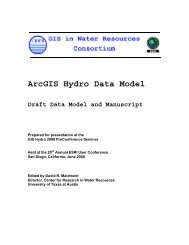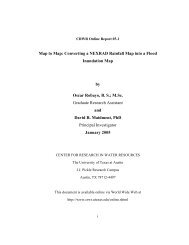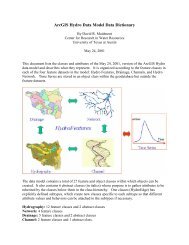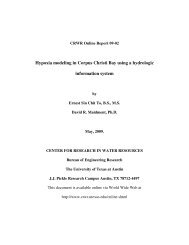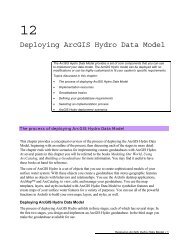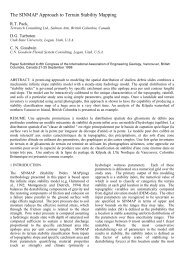View the Whole Report - Center for Research in Water Resources ...
View the Whole Report - Center for Research in Water Resources ...
View the Whole Report - Center for Research in Water Resources ...
You also want an ePaper? Increase the reach of your titles
YUMPU automatically turns print PDFs into web optimized ePapers that Google loves.
concentrated flow which promoted erosion below <strong>the</strong> structure and resulted <strong>in</strong> short<br />
circuit<strong>in</strong>g <strong>in</strong> <strong>the</strong> ponded area.<br />
In contrast to <strong>the</strong> field monitor<strong>in</strong>g, high removal efficiencies were achieved with<br />
silt fences <strong>in</strong> <strong>the</strong> flume studies. The geometry of <strong>the</strong> flume created a large ponded area<br />
beh<strong>in</strong>d <strong>the</strong> controls result<strong>in</strong>g <strong>in</strong> long detention times and significant particle settl<strong>in</strong>g even<br />
with <strong>the</strong> f<strong>in</strong>e-gra<strong>in</strong>ed sediment used <strong>in</strong> <strong>the</strong> tests. Mean sediment removal efficiency <strong>in</strong> <strong>the</strong><br />
flume ranged from 68 to 90% and was highly correlated with <strong>the</strong> detention time of <strong>the</strong><br />
runoff. This <strong>in</strong>dicates that silt fences should be sited <strong>in</strong> <strong>the</strong> field so as to maximize <strong>the</strong><br />
ponded volume beh<strong>in</strong>d <strong>the</strong> fence.<br />
Sediment-laden runoff flow rates through <strong>the</strong> controls were two orders of<br />
magnitude less than those typically specified by transportation agencies. The flow rates<br />
of a sediment slurry through geotextile fences are a function of apparent open<strong>in</strong>g size as<br />
well as permittivity (or o<strong>the</strong>r measures of clean water flowrates). The fabric result<strong>in</strong>g <strong>in</strong><br />
<strong>the</strong> longest detention times <strong>in</strong> this series of flume tests had <strong>the</strong> highest reported<br />
permittivity, but it also had <strong>the</strong> smallest apparent open<strong>in</strong>g size, suggest<strong>in</strong>g that clogg<strong>in</strong>g<br />
of <strong>the</strong> fabric with sediment affected its hydraulic per<strong>for</strong>mance. Field per<strong>for</strong>mance can not<br />
be determ<strong>in</strong>ed from current parameters used to characterize <strong>the</strong> hydraulic properties of<br />
<strong>the</strong>se fabrics.<br />
In addition, tests of silt fence fabrics <strong>in</strong> a modified permeameter showed that<br />
flowrates through <strong>the</strong> fabric were not l<strong>in</strong>early related to head as is assumed <strong>in</strong> <strong>the</strong> ASTM<br />
def<strong>in</strong>ition. The discrepancy was due to <strong>the</strong> fact that flow at <strong>the</strong> heads fabrics are<br />
subjected to <strong>in</strong> silt fence applications is turbulent result<strong>in</strong>g <strong>in</strong> much lower flow rates.<br />
Permeameter tests of silt fence fabrics confirmed that entrapped air is not <strong>the</strong> cause of <strong>the</strong><br />
much lower flowrates.<br />
Flowrates through rock berms greatly exceeded <strong>the</strong> rates typically recommended<br />
<strong>in</strong> regulatory agency guidel<strong>in</strong>es. The short detention times and large pore size of <strong>the</strong><br />
berms resulted <strong>in</strong> only a slight reduction <strong>in</strong> <strong>the</strong> suspended solids load <strong>in</strong> <strong>the</strong> flume tests.<br />
Development of a new test or series of tests to characterize <strong>the</strong> expected<br />
per<strong>for</strong>mance of geotextile fabrics when used as silt fences is urgently needed. The use of<br />
current parameters results <strong>in</strong> an over-estimate of <strong>the</strong> area that can be treated without over-<br />
54




